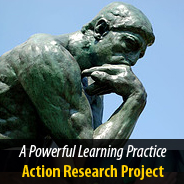The problem we faced was a misconception of what inventive thinking looked like in a classroom. Our conception was that inventive thinking could be utilized by a small percentage of the student population. We thought most students didn’t know how to or even want to invent new ideas or new solutions to problems. We questioned if middle school students were capable of inventive thinking across various academic disciplines.
We initially wrestled with the following four questions: What is inventive thinking? What does the teacher do in a classroom where inventive thinking is occurring? What does the student do? How do we know when a student is inventively thinking? We needed a model to design units of instruction and decided to use Problem Based Learning (PBL) as a tool to aid in unit development. We collected student, teacher, and community feedback, and also collected student work samples.
In
Social Studies students were provided with a letter from Roman emperor Numerius dated 283 C.E. The students had to pull out the problems described by the emperor and pick one problem to research thoroughly. The class wiki “Roman Time Machine” was set up so students with the same topic could collaborate ideas and research with those in other classes. The driving question was
Can we use current knowledge, information, and resources to solve the problems of the Roman Empire? Students were required to research not only using the internet but by contacting experts in various fields through skype, email, phone, twitter, and setting up appointments for interviews. The final product required students to explain their answer to the driving question using a 21st century real world tool. See a wiki created for the project: http://romantimemachine.wikispaces.com/
In Language Arts there were two units:
In one of those units, students had just finished reading Tangerine, a story which includes many environmental issues. The students were asked to choose an issue they knew was something relevant to today, whether local or on a larger scale. Their goal was to use their previous knowledge to drive their research in order to make an attempt at solving or preventing this environment issue. After researching, they were to create a five step action plan for combatting the problem and take action by writing a letter and sending it to a company or individual who may be able to make a difference. Students were able to work with other students, and not necessarily a student within their classroom. Many opted to work with a student in a different class period and used tools such as Diigo to share their research. Their option for the final product could be anything they chose. Some students opted for a pamphlet to send out with their letter, while others created websites or movies.
In the second unit students found solutions to problems that had not been solved. Students were asked to choose an environmental issue in which they felt passionate. To help them think about issues, a Livebinder was created with links to shark finning and the Great Pacific Garbage Patch. Sites were attached that had short video clips of many types of environmental issues. The students spent time looking at these and then chose their topics. They researched their issue, shared links and information via Diigo and reached out to experts for information (Schoology was used to make contacts). Students collaborated with other students who were researching similar issues. Once students decided how to solve the environmental issue, they had to find someone to write to for help in making their solution a reality. Students wrote letters and sent them.
In Science students were given a problem to solve for the Director of the Duke Energy Cincinnati Children’s Museum: design a Rube Goldberg inspired contraption that has a clear beginning and end that delivers a sticker to a child, ages 2-10. The contraption should be designed to museum quality standards: no choking hazards, inspire children to learn about energy transformation, and keep guests coming back to experience the exhibit through an engaging design. Student designs were judged by the Director and a team of Museum staff. Six teams were awarded a top prize and 12 teams were awarded honorable mentions.
Three themes emerged throughout the five units of instruction: Authentic Tasks, Student Ownership, and Connected Learning.
What is the teacher doing before a class where inventive thinking is occurring? Designing authentic tasks.
Authentic Tasks invite students to solve problems that have a wide range of possible outcomes and/or solutions. Planning such units of instruction require mastery of content, ample planning time to connect content and problem(s), and ample instructional time to connect content to student outcomes.
What is a student doing when inventive thinking is occurring? Owning their learning and connecting with others.
Student Ownership requires teacher respect for student prior knowledge, time for student exploration before formal teacher presentation, and lesson focus on student generated ideas and questions.
Connected Learning should focus students participating in social interactions with their peers, teachers, and outside sources to generate arguments supported with evidence leading into rigorous debate. How do we know when students have inventively thought? Students become vested in the product they have produced. It is more than a grade. It is more than an assignment checked off of a box on a teacher checlist. Passion happens.
The team has gathered a wealth of resources and links to articles about project-based learning and authentic learning. You can find these links and more on their
team wiki page.


